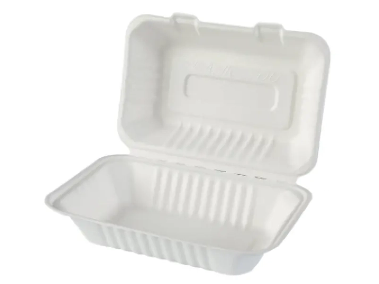Are take-out containers recyclable? Find out which materials are recyclable and how to properly dispose of your food packaging without harming the environment. Did you know 60% of "eco-friendly" takeout boxes aren’t truly compostable? Many containers labeled "biodegradable" still leave microplastics.
Compostable containers must meet strict standards, like breaking down in 90 days. Look for BPI certification to avoid greenwashing.
| Factor | Compostable | Biodegradable |
|---|---|---|
| Timeframe | ≤90–180 days4,8 | Years4,6 |
| End Result | Soil nutrients6,8 | Microplastics6,8 |
| Certification | BPI/EN 134324,6,7,8 | None4,6,7,8 |

Q: What are take-out containers made of?
A: Take-out containers are often made from paperboard, plastic, or plant-based materials. Compostable containers are made from bamboo, plant fibers, or PLA, while plastic-lined or glossy containers may contain non-compostable materials.
Q: Can takeout food containers be recycled?
A: Most disposable takeout containers cannot be recycled, especially those with plastic liners or wax coatings. Only some paper containers without coatings can be recycled if they are clean.
Q: What is the meaning of take-out container?
A: A take-out container is a packaging used for food to be taken away from the restaurant or store, typically made from paper, plastic, or compostable materials.
Q: How to tell if a takeout container is compostable?
A: Look for "compostable" labels or certifications like BPI. Containers without shiny coatings or plastic liners are more likely to be compostable.
Q: Are takeout containers safe?
A: Takeout containers are generally safe for food use, but it's important to choose certified compostable or recyclable options to ensure they don't contain harmful materials like plastic liners.
| Material | Resource Saved | Benefit |
|---|---|---|
| Sugarcane | Fossil fuels | Uses agricultural waste |
| PLA (Cornstarch) | 68% less CO₂ vs plastic | Renewable crop-based production |
Pro Tip: Pair compostable containers with local compost programs for full environmental impact.
To earn a BPI certification, containers must:
Break down completely in 90 days
Leave no toxic residue
Pass ASTM D6868 industrial tests
Popular materials like sugarcane fiber (bagasse) meet these rules. But watch out for sneaky additives – some "eco-friendly" containers still use PFAS chemicals that contaminate compost.
Microwave Tip: Certified compostable sugarcane containers handle 3-minute heating cycles. Plastic-coated "biodegradable" boxes? They'll melt or leak chemicals.
Compostable containers break down into nutrient-rich soil within 90 days . Biodegradable items can take years and leave microplastics . Always check certifications like BPI instead of vague "eco-friendly" labels.
Quick Check:
Compostable = Soil-safe in months
Biodegradable = Unknown timeline, risky residues
BPI-certified containers pass strict tests:
Full decomposition in 90 days
No toxic residues (e.g., PFAS-free)
Safe for industrial compost facilities (55-60°C)
Materials like sugarcane fiber (bagasse) excel here. Plastic-coated "biodegradable" boxes fail these tests.
| Material | Compost Time | Best For |
|---|---|---|
| Sugarcane | 30 days | Hot soups, microwaving |
| Bamboo | 30-45 days | Salads, cold dishes |
| PLA (Cornstarch) | 90 days | Commercial composting only |
Microwave Tip: Sugarcane containers handle 3-minute heating. PLA warps if overheated.

Plastic coatings: Shiny surfaces = polyethylene (PE)
Black plastic: Non-recyclable and non-compostable
Foam containers: Never compostable (polystyrene)
Tear the edge of containers. Rough fibers = good. Smooth layers = plastic.
Only 15% of U.S. areas have industrial compost facilities. Certified containers often end up in landfills due to:
Contamination (grease, non-compostable lids)
Lack of local partnerships
| Material | Home Compost Time | Tips |
|---|---|---|
| Bagasse | 3-6 months | Chop into pieces |
| PLA | Not recommended | Needs 60°C+ heat |
Mix compostable containers with food scraps. Turn the pile weekly for faster breakdown.
Ask restaurants: “Do you use BPI-certified containers?”
Check apps: Litterati locates nearby compost hubs.
BYOC (Bring Your Own Container): Reduces waste by 100%.
Pro Tip: Freeze leftovers in sugarcane containers. They’re freezer-safe and odor-resistant.
Compostable containers break down into soil in 90 days under strict conditions. Biodegradable options often leave microplastics and lack certifications. Look for BPI/EN13432 logos to avoid greenwashing.
Quick Check:
Compostable = Soil-safe in months
Biodegradable = Years + microplastics
| Material | Pros | Cons |
|---|---|---|
| Sugarcane | Microwave-safe, 30-day compost | Heavy grease may stain |
| PLA (Cornstarch) | Breaks down in facilities | Fails in home compost |
| Bamboo | Natural, no coatings | Limited heat resistance |
Some compostable containers use PFAS chemicals for waterproofing. These can turn into harmful acids in compost.
Only 15% of U.S. cities accept compostable containers. Even certified items get trashed if facilities lack agreements.
Home Composting Hacks:
Chop sugarcane containers into pieces (3-6 months)
Avoid PLA – needs 60°C+ heat
Ask: “Is this BPI-certified?” at restaurants.
Scan: Use apps like Litterati for compost hubs.
Avoid: Glossy/plastic-lined containers – tear-test edges.
Did You Know? Seaweed-based lids and mushroom packaging are emerging as PFAS-free alternatives. Studies show PFAS from compostable containers can persist in soil. Always check for "PFAS-free" labels.
Take-out containers come in a variety of materials, including plastic, paperboard, and compostable options. Not all containers are eco-friendly, as many are lined with plastic or wax, making them non-recyclable and non-compostable. To ensure you're making the right choice, look for certification labels such as BPI or check for signs like glossy coatings. Compostable containers made from plant-based materials, like bamboo and PLA, are ideal for environmentally conscious disposal.